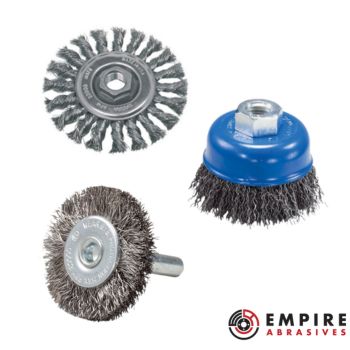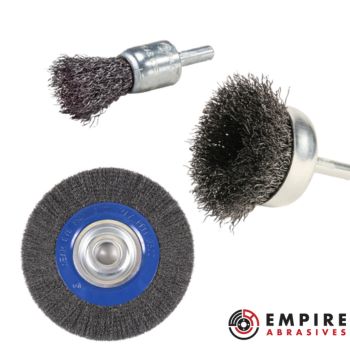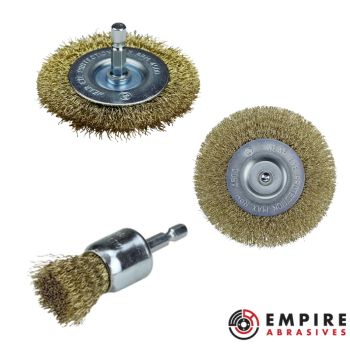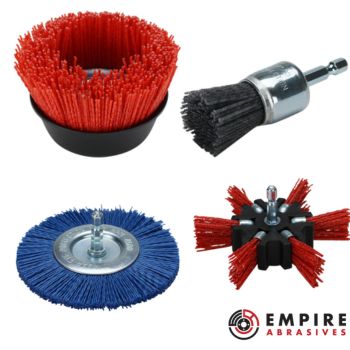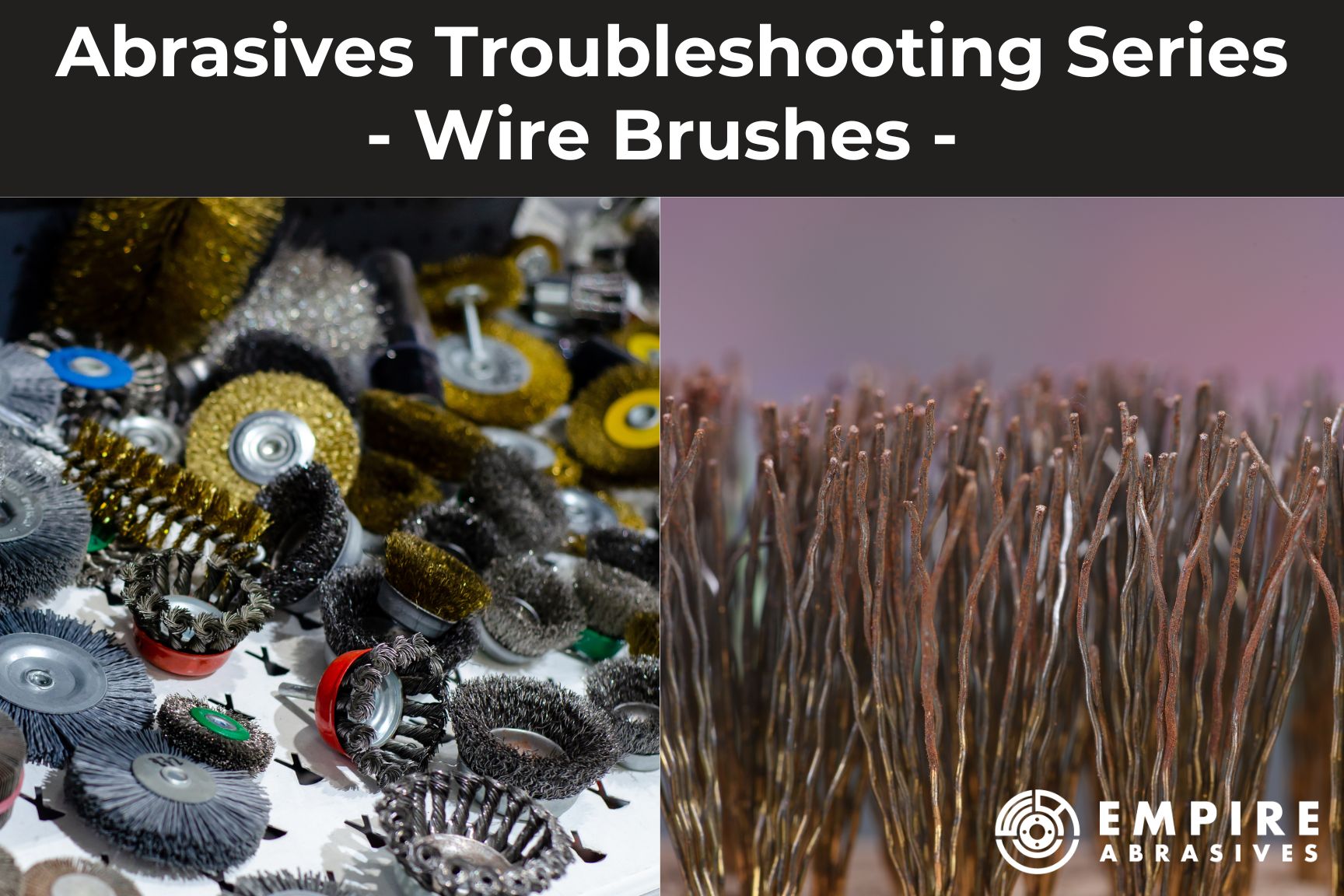
Wire brushes are essential tools that find applications across various industries such as manufacturing, construction, and automotive repair. You'll find these brushes crucial for tasks ranging from cleaning rust and removing paint to preparing surfaces for welding.
However, like all tools, wire brushes can face specific issues that hinder their performance or even lead to failure. This guide is here to help you navigate the common problems you might face with your wire brush, offering solutions whether you're a seasoned professional or a DIY enthusiast.
This article is part of Empire Abrasives’ series on troubleshooting common abrasive tool issues.
Jump Ahead
About Wire Brushes
Wire brushes are a type of abrasive tool that uses stiff wires to remove rust, scale, paint, and other contaminants from surfaces. Wire brushes come in a variety of sizes and various forms, such as cup brushes, end brushes, wire wheels, and handheld wire brushes.
Each type has its specific uses and applications in multiple fields.
Types of Wire Brushes
Cup Brushes
Cup brushes are widely used in industrial settings. They are perfect for removing scale, rust, and paint from metal surfaces. The cup-like shape allows you to quickly cover a large surface area, making them efficient for cleaning large objects.
End Brushes
End brushes are designed to help you reach tight and confined spaces, so you can use them to clean weld seams, deburr, and remove rust from corners and edges. These brushes have stiff bristles penetrating small crevices, making them invaluable in precision cleaning.
Wire Wheels
Wire wheels come in various sizes and can be attached to power tools like bench grinders, power drills, and angle grinders. You can use them for cleaning, deburring, polishing, and surface preparation. Their wheel-like shape makes them suitable for rounded or contoured surfaces.
Handheld Wire Brushes
Unlike the above, handheld wire brushes are manual tools, usually featuring a wooden or plastic handle, making them easy to grip and maneuver. These are the traditional wire brushes that most people are familiar with. Handheld wire brushes are perfect for detail work, reaching areas that power tools can't access, and for tasks that require a lighter hand. For those detailed and meticulous tasks, especially in welding, scratch brushes and welders toothbrushes are the go-to precision tools.
*This article covers troubleshooting for wire brushes attached to power tools and does not cover troubleshooting specifically for handheld wire brushes. Though, some of the issues and solutions are still the same.
Applications of Wire Brushes
You can use wire brushes for multiple applications across several industries. Some of the most common applications are highlighted below:
Cleaning
Wire brushes are primarily used for cleaning surfaces, removing rust, scale, and old paint. They are also useful in cleaning weld seams.
Surface Preparation
You'll often need to roughen surfaces before painting or coating. Wire brushes provide the necessary abrasiveness to prepare surfaces for these processes.
Polishing
Some wire brushes, especially those with fine bristles, are used for polishing and finishing metal surfaces, giving them a smooth and shiny appearance.
Deburring
After cutting or machining, metal parts often have sharp edges or burrs. Wire brushes can help you deburr these edges, making the details safe to handle.
Welding Preparation
Wire brushes clean and prepare metal surfaces for welding, ensuring a strong and clean weld.
Materials and Types
Wire brushes are made using different materials, such as stainless steel, brass coated, carbon steel, and nylon filament. The type of wire you choose will depend on the material you're cleaning and the desired results:
Stainless Steel Wire Brushes: Known for their rust-resistance, these brushes are particularly useful for cleaning stainless steel surfaces without causing contamination. They offer a balance between abrasiveness and gentleness, ensuring effective cleaning without excessive wear.
Carbon Steel Wire Brushes: Strong and highly abrasive brushes, ideal for heavy-duty cleaning tasks and fast material removal. They excel in removing rust, paint, and scale from ferrous metals. They are a good choice for general-purpose cleaning tasks
Brass Coated Wire Brushes: These brushes have the strength of steel, but they are coated with brass to be less aggressive. This makes them perfect for cleaning non-ferrous metals like brass or copper, without leaving scratches or marks.
Nylon Wire Brushes: Nylon brushes are softer and flexible, making them better for delicate surfaces or finishes that can be easily scratched. They are often used for light cleaning and polishing tasks, and very popular for Shou Sugi Ban surface prep. They are also non-conductive, making them safe to use in flammable environments.
Common Wire Brush Issues
When you use wire brushes, various issues can arise, impacting their effectiveness and longevity. Understanding these problems and how to troubleshoot and prevent them can save you time and resources. Below are some of the common issues faced by users of wire brushes.
Wire Breakage
Wire breakage refers to snapping individual bristles in a wire brush. This problem can severely affect the brush's cleaning ability because the bristles are no longer able to make contact with the surface being cleaned. Additionally, the broken wires can fly off during use, which can pose a safety hazard.
Causes of Wire Breakage
- Using the brush at excessive speeds
- Applying too much pressure during cleaning
- Using a brush with the wrong type of wire for the material being cleaned
- Using an old or worn-out brush
- Storing the wire brush in a humid or wet environment
- Poor quality of the brush: Inferior manufacturing or materials can lead to premature breakage. At Empire Abrasives, we only use the best materials for our wire brushes.
Troubleshooting and Prevention Tips for Wire Breakage
- Always follow the manufacturer's recommended speed for the brush
- Apply gentle pressure and let the brush do the work
- Choose the right type of wire (e.g., steel, brass) for cleaning the material
- Regularly inspect the brush for signs of wear and replace as needed
- Regular clean your brushes to prevent buildup, which can cause added stress on the bristles
- Store the wire brush in a dry, cool place
If you notice that the wires on your wire brush are breaking frequently, it is important to stop using the brush and replace it. Broken wires can fly off and pose a safety hazard.
Ineffective Cleaning
If a wire brush doesn't appear to be doing a good job of removing dirt, rust, or other contaminants, it's not cleaning effectively. This can lead to more time spent cleaning, and it can also affect later processes like painting or welding.
Causes of Ineffective Cleaning
- Using an old or worn-out brush
- Using the wrong type of brush for the task
- Inappropriate speed or pressure during cleaning
- Buildup of debris or contaminants on the brush
- The brush isn't making proper contact with the surface
Troubleshooting and Prevention Tips for Ineffective Cleaning
- Inspect the brush regularly and replace it if it shows signs of wear
- Match the brush type (e.g., cup, end) with the specific cleaning task
- Make sure the brush is at the correct angle to the work surface
- Follow the manufacturer's guidelines on speed and pressure
- Consider using a solvent or cleaner with the wire brush if needed
- For heavily soiled surfaces, consider a pre-cleaning step
- Clean brushes after each use to prevent debris buildup
Rapid Wear
Rapid wear refers to the quick deterioration of the wire brush, reducing cleaning efficiency and the need for frequent replacements.
Causes of Rapid Wear
- Using the brush on materials that are too hard for the wire type
- Operating at excessive speeds
- Improper storage, leading to rust or other damage
- Frequent use without adequate breaks, causing excessive heat and wear
- Applying uneven/inconsistent pressure can lead to rapid wear in specific areas of the brush
Troubleshooting and prevention tips for rapid wear:
- Select the proper wire material for the surface being cleaned
- Adhere to the recommended speed settings
- Try to maintain even pressure to distribute wear uniformly across the brush
- Store the brush in a dry, clean area to prevent rust and other damage
- Take breaks to allow the brush to cool
Surface Damage
Surface damage refers to scratches, gouges, or other unwanted alterations to the material's surface being cleaned. This damage can lead to aesthetic problems or even weaken the material's structure.
Causes of Surface Damage:
- Using a wire brush that's too abrasive for the material
- Applying excessive pressure during cleaning
- Operating at incorrect speeds or varying the speed during operation
- Not regularly inspecting the brush for damaged or misaligned bristles
Troubleshooting and Prevention Tips for Surface Damage
- Choose a wire brush with the material's appropriate wire type and hardness
- Use gentle pressure and let the tool do the work
- Keep the operating speed consistent
- Follow the manufacturer's instructions on optimal operating speed
Rusting
Rusting refers to the corrosion of the wire bristles, leading to reduced effectiveness and the potential spread of rust to the surfaces being cleaned.
Causes of Rusting
- Storing in a humid or wet environment
- Using the brush on corrosive materials without proper cleaning afterwards
- Using the brush with corrosive chemicals can accelerate rusting
Troubleshooting and Prevention Tips for Rusting
- Store the wire brushes in a dry and clean environment
- Clean the brush thoroughly after using it on corrosive materials
- Consider using stainless steel or other rust-resistant wire types
Overheating
Overheating can occur in the wire brush and the cleaned material. It may cause the wire to become brittle and break or negatively affect the surface properties of the cleaned material.
Causes of Overheating:
- Operating at excessively high speeds
- Applying too much pressure
- Using the brush continuously for extended periods without breaks
Troubleshooting and Prevention Tips for Overheating
- Follow the recommended speed settings provided by the manufacturer
- Use the brush with consistent but gentle pressure
- Allow the brush and material to cool down periodically during extended use
By addressing these wire brush problems, you can ensure that you use these tools effectively and efficiently, avoiding common issues that can lead to wasted time, resources, and potential damage to materials.
Additional Tips for Using Wire Brushes
Wire brushes are valuable tools but can quickly become a liability if not handled carefully. Here are some wire brush usage tips:
- Safety First: Always wear protective eyewear and gloves to avoid injury from flying wire or debris.
- Correct Attachment: Ensure the wire brush is correctly attached to your power tool, following the manufacturer’s instructions.
- Proper Storage: Store wire brushes in a way that doesn’t bend or deform the bristles and away from moisture to prevent rusting.
- Regular Inspection: Inspect wire brushes for signs of wear, damage, or other issues. Replace them as needed to maintain performance and safety.
- Wire Brush Maintenance: Clean the wire brushes after use to remove any residue, especially when used on corrosive materials, to prolong their life.
- Use the Right Type: Understand the different types of wire brushes (cup brushes, end brushes, wire wheels) and choose the right one for the specific task. For example, a cup brush is a good choice for removing rust and scale from a large surface, while an end brush is better for cleaning in tight spaces.
- Use the Right Pressure: Too much pressure can damage the surface being cleaned. Let the abrasive do the work for you, without pressing too hard into the surface being worked on.
From recognizing common issues like wire breakage, ineffective cleaning, rapid wear, surface damage, rusting, and overheating to employing troubleshooting and prevention techniques, you can enhance the efficiency and longevity of their wire brushes. The additional tips provided further support with a rewarding and safe experience.
Conclusion
Wire brushes are versatile tools used in various industries for cleaning, deburring, rust removal, and surface preparation. However, these benefits can only be fully realized through proper understanding and care of the tools.
Empire Abrasives remains a trustworthy source for high-quality wire brushes and the insights and guidance needed to make the most of them. Wire brush troubleshooting can make any DIY project or professional task successful.
By adhering to these guidelines, professionals and DIY enthusiasts can make the most of their wire brushes, achieving desired results without the frustration of common problems.
Still Have Questions?
We’re always happy to help! Our abrasives experts are available to talk on the phone or website chat during regular office hours, or you can leave us a voicemail or email during off-hours.
Abrasive Troubleshooting Guides
More from our abrasives troubleshooting series:
- Troubleshooting Common Abrasive Tool Issues - Sanding Belts
- Troubleshooting Common Abrasive Tool Issues - Cut-Off Wheels
- Troubleshooting Common Abrasive Tool Issues - Grinding Wheels for Angle Grinders
- Troubleshooting Common Abrasive Tool Issues - Tungsten Carbide Burrs
- Troubleshooting Common Abrasive Tool Issues - Flap Discs





